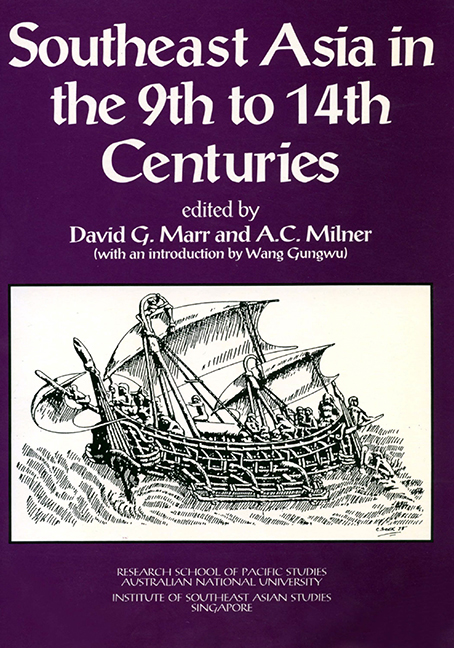Book contents
- Frontmatter
- Contents
- Contributors
- Preface
- Introduction
- 1 The Early and the Imperial Kingdom in Southeast Asian History
- 2 Hydraulic Works and South East Asian Polities
- 3 Some Notes on Relations between Central and Local Government in Ancient Java
- 4 Negara, Mandala, and Despotic State: Images of Early Java
- 5 Some Remarks on Early State Formation in Cambodia
- 6 “Elephants Can Actually Swim”: Contemporary Chinese Views of Late Ly Dai Viet
- 7 Authority and Legitimacy in 11th Century Vietnam
- 8 From Myth to History: Imagined Polities in 14th Century Vietnam
- 9 Shipshape Societies: Boat Symbolism and Political Systems in Insular Southeast Asia
- 10 Changing Perspectives in Island Southeast Asia
- 11 Political and Cultural Continuities at Dvaravati Sites
- 12 The True and the Corbel Arch in Mainland Southeast Asian Monumental Architecture
- 13 Vietnamese Ceramics and Cultural Identity: Evidence from the Ly and Tran Dynasties
- 14 Traditions, Acculturation, Renovation: The Evolutional Pattern of Vietnamese Culture
- 15 Symbolism of Kingship in Arakan
- 16 Buddhism in Champa
- 17 The Ordering of Generations: Change and Continuity in Old Javanese Kinship
- 18 Sources on Economic Activities in Khmer and Cham Lands
- 19 Narrative Bas-Reliefs at Candi Surawana
- 20 Possibilities for a Reading of the 1293-1357 Period in the Vietnamese Annals
- Index
- Miscellaneous Endmatter
4 - Negara, Mandala, and Despotic State: Images of Early Java
Published online by Cambridge University Press: 21 October 2015
- Frontmatter
- Contents
- Contributors
- Preface
- Introduction
- 1 The Early and the Imperial Kingdom in Southeast Asian History
- 2 Hydraulic Works and South East Asian Polities
- 3 Some Notes on Relations between Central and Local Government in Ancient Java
- 4 Negara, Mandala, and Despotic State: Images of Early Java
- 5 Some Remarks on Early State Formation in Cambodia
- 6 “Elephants Can Actually Swim”: Contemporary Chinese Views of Late Ly Dai Viet
- 7 Authority and Legitimacy in 11th Century Vietnam
- 8 From Myth to History: Imagined Polities in 14th Century Vietnam
- 9 Shipshape Societies: Boat Symbolism and Political Systems in Insular Southeast Asia
- 10 Changing Perspectives in Island Southeast Asia
- 11 Political and Cultural Continuities at Dvaravati Sites
- 12 The True and the Corbel Arch in Mainland Southeast Asian Monumental Architecture
- 13 Vietnamese Ceramics and Cultural Identity: Evidence from the Ly and Tran Dynasties
- 14 Traditions, Acculturation, Renovation: The Evolutional Pattern of Vietnamese Culture
- 15 Symbolism of Kingship in Arakan
- 16 Buddhism in Champa
- 17 The Ordering of Generations: Change and Continuity in Old Javanese Kinship
- 18 Sources on Economic Activities in Khmer and Cham Lands
- 19 Narrative Bas-Reliefs at Candi Surawana
- 20 Possibilities for a Reading of the 1293-1357 Period in the Vietnamese Annals
- Index
- Miscellaneous Endmatter
Summary
Introduction: models and trends in the study of early states
The study of the pre-colonial history of Southeast Asia, once the undisputed preserve of Sanskritists and Indian cultural historians, has since the Second World War been taken up by a broader range of scholars, and has, as a consequence, been influenced by the series of debates and intellectual fashions which have enlivened the disciplines of sociology and anthropology. Heine-Geldern's (1942) study of the religious basis of state and kingship in Southeast Asia was succeeded in the 1950's by the influence of the Weberian notion of the patrimonial state. The late fifties and sixties saw an accumulation of economically-oriented studies inspired in turn by Polanyist substantivism, Wittfogel's Hydraulic Society, and Marxian Asiatic Mode of Production. With the seventies came a partial retreat into structuralist and symbolic studies of myth, ritual and hierarchy. Then, as the momentum of structuralism began to dissipate, the influence of the schools political and the more Marxian critical anthropology asserted itself, reviving some of the debates of the sixties. By no means all scholars interested in early Southeast Asia have participated in recent debates. Many, including the majority of those dealing with primary data, have unfortunately held aloof from them.
Groupings which have emerged amongst the participants in recent debates and their followers have their roots in cleavages that began to appear during the 1960's. These debates, however, address only a portion of the assumptions underlying recent work. As a result, apparently opposing models tend to overlap in certain key areas. The influences of Weber and Heine-Geldern have endured, as have some entrenched images of Further India inherited from Coedes and his predecessors. Few of these ideas have been questioned and almost none finally discarded by general agreement. There has been overall a marked preference shown by those of all shades of opinion for static rather than dynamic models. As a result there has been a general tendency to perceive change in the early states of the region as exogenous both in cause and in agent, and a related inclination to focus upon - and perhaps overstress - structural continuities in the societies studied. Endogenous change, particularly in areas of culture and social structure, has often been neither expected nor perceived.
- Type
- Chapter
- Information
- Southeast Asia in the 9th to 14th Centuries , pp. 65 - 94Publisher: ISEAS–Yusof Ishak InstitutePrint publication year: 1986



